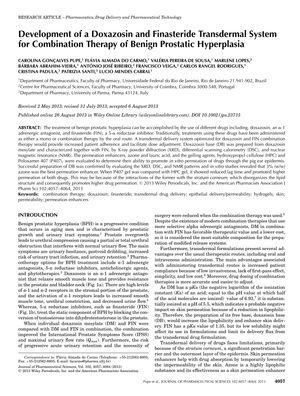Development of a Doxazosin and Finasteride Transdermal System for Combination Therapy of Benign Prostatic Hyperplasia
August 2013
in “
Journal of pharmaceutical sciences
”

TLDR Researchers created a skin patch that delivers two drugs for treating enlarged prostate, which may improve patient use and dosage control.
In 2013, researchers developed a transdermal delivery system for the combination therapy of benign prostatic hyperplasia using doxazosin, an α-1 adrenergic antagonist, and finasteride, a 5-α reductase inhibitor. They prepared doxazosin base (DB) from doxazosin mesylate and characterized it along with finasteride using X-ray powder diffraction (XRD), differential scanning calorimetry (DSC), and nuclear magnetic resonance (NMR). In vitro studies were conducted to evaluate the effectiveness of permeation enhancers and gelling agents in facilitating drug permeation through pig ear epidermis. The study found that 3% (w/w) azone was the most effective permeation enhancer and that Poloxamer 407 (P407) gel was superior to hydroxypropyl cellulose (HPC) gel in reducing lag time and increasing permeation of both drugs, likely due to its interaction with the stratum corneum. This transdermal system could potentially improve patient adherence and allow for easier dose adjustment in the treatment of benign prostatic hyperplasia.
